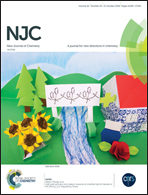Gaining insight into the photophysical properties of a coumarin STP ester with potential for bioconjugation†
Abstract
The photophysical properties of a coumarin 392 4-sulfotetrafluorophenyl ester, C392STP (sodium (E/Z)-4-(4-(2-(6,7-dimethoxycoumarin-3-yl)vinyl)-benzoyl)-2,3,5,6-tetrafluoro-benzenesulfonate), an amine reactive coumarin with potential for bioconjungation, have been studied in different solvents. When increasing the solvent polarity, strong red shifts (31 to 56 nm on going from dioxane to DMSO and PBS, respectively) were observed in the emission spectra while there were minor changes in the absorption spectra. It was found that in addition to non-specific solute–solvent interactions, in protic solvents specific interactions such as hydrogen-bonding occurred. The photophysical behaviour of coumarin also pointed to an increase of the polarity of the molecule upon excitation. The molar absorption coefficient, ε385 = 1.03 × 104 M−1 cm−1, and brightness, ε × Φ = 1.18 × 103 M−1 cm−1, of the coumarin ester were found to be moderate in PBS even if the fluorescence quantum yield (Φ = 0.115) was found to be relatively low. The large Stokes shifts (Δλ = λem − λabs was found to increase from 74 nm in dioxane to 136 nm in PBS), photostability and pH insensitivity are characteristics that turn C392STP into a promising fluorescent dye with potential applications in different fields.



 Please wait while we load your content...
Please wait while we load your content...